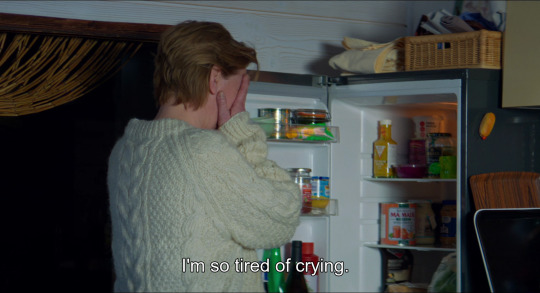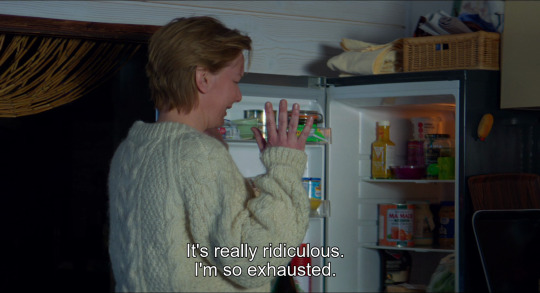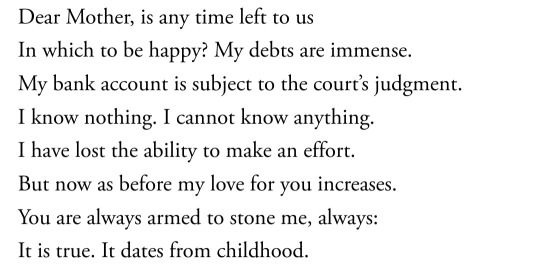#linked excerpts
Explore tagged Tumblr posts
Text

Top, Paul Mpagi Sepuya, Gallery Gazing Ball (DSCF1919), 2024, Archival pigment print, Artwork: 24 × 18 in (61 × 45.5 cm), Framed: 24 1/4 × 18 1/4 in (61.5 × 46.5 cm). From the solo exhibition Trance, at Bortolami, on view January 10 - March 1, 2025. Via. Bottom, Tony Oursler, The Most Beautiful Thing I’ve Never Seen, 1995, Sofa, mannequin and video, projection, colour and sound, dimensions variable. Via.
--
With the advent of psychoanalysis, the mirror image became primarily associated with the process of identity formation and, in particular, with fundamental psychological distinctions such as the self and the other, or the conscious and the unconscious. Among the most notable examples in psychoanalytic theory is Lacan’s mirror stage, describing the process whereby the child recognizes his/her body image in the mirror, thus developing a sense of self and ideal wholeness but also, when looking back at its flesh-and-blood self, a crisis of imperfection and fragmentation. For Freud, a mirror image forming a double always conjures up the notion of death, which is why we experience the sight of our double uncanny. Through doubling, the subject perceives him/herself as decomposed and sees his/her counterpart as a threat. “There is nothing more uncanny,” writes Heinrich Heine, “than seeing one’s face accidentally in a mirror by moonlight”.
Petra Eckhard, from Chronotopes of the Uncanny: Time and Space in Postmodern New York Novels. Paul Auster's »City of Glass« and Toni Morrison's »Jazz«, 2011. Via.
12 notes
·
View notes
Text
Screen captures from Anatomy of a Fall, directed by Justine Triet, 2023.
--
Back in 1991 when the book (Mirror Worlds: or the Day Software Puts the Universe in a Shoebox...How It Will Happen and What It Will Mean) was first published, just over 1% of Americans were using the internet. But Gelernter claimed computing was about to revolutionize life on Earth. “This book describes an event that will happen someday soon,” he wrote in the opening line. “You will look into a computer screen and see reality. Some part of your world — the town you live in, the company you work for, your school system, the city hospital — will hang there in a sharp color image, abstract but recognizable, moving subtly in a thousand places.”
In essence, Gelernter believed that every aspect of life could soon be modeled in a parallel digital simulation. Everything happening in our lived reality would be tracked and monitored and fed into software “by a steady rush of new data pouring in through cables” to create a high-fidelity real-time digital representation of the world and all of its pulsing, swarming and sensuous qualities. This would be like Mark Zuckerberg’s metaverse on steroids: our exact world, our very lives, all digital. And you could view, manipulate, experience and interact with this mirror world, like a child with a dollhouse. A dashboard for reality.
These “high-tech voodoo dolls,” as Gelernter described them, “will mark a new era in mankind’s relationship to the man-made world. They change that relationship; for good.” It would be possible, he believed, to not just monitor what was happening around the world, but also to predict what could happen — endless simulations of possible future events would be running inside the mirror world. We could prepare ourselves for any outcome — any future — in the physical world because we would know what was coming. (...)
The dream of a digital twin is to bypass the averages and biases and develop a personalized and predictive form of healthcare that is built around a person’s specific physiology and pathology rather than vaguely representative historical data. “The idea [of the virtual human] starts from the premise that modern medicine isn’t really that modern in scientific terms,” Peter Coveney, a computer scientist and coauthor of “Virtual You” (2023), told me over Zoom. Coveney worked on a project to digitally twin the entire 60,000-mile-long circulatory system of a deceased South Korean woman named Yoon-Sun who had donated her body to science. Cross-sections were taken from her frozen cadaver to help trace the network of vessels, arteries, veins and capillaries. Once mapped, they created a digital simulation of how her blood flowed by feeding 200,000 lines of code into a supercomputer.
Joe Zadeh, from A Digital Twin Might Just Save Your Life - Digital twins offer humankind the ability to command virtual replicas of forests, oil fields, cities, supply chains — and even, maybe one day, our very bodies, for Noéma, March 21, 2024.


Anatomy of a Fall (2023)
3K notes
·
View notes
Text
In recent years, there has been a rush on the internet to supply image descriptions and to call out those who don’t. This may be an example of community accountability at work, but it’s striking to observe that those doing the most fierce calling out or correcting are sighted people. Such efforts are largely self-defeating. I cannot count the times I’ve stopped reading a video transcript because it started with a dense word picture. Even if a description is short and well done, I often wish there were no description at all. Get to the point, already! How ironic that striving after access can actually create a barrier. When I pointed this out during one of my seminars, a participant made us all laugh by doing a parody: “Mary is wearing a green, blue, and red striped shirt; every fourth stripe also has a purple dot the size of a pea in it, and there are forty-seven stripes—”
“You’re killing me,” I said. “I can’t take any more of that!”
Now serious, she said it was clear to her that none of that stuff about Mary’s clothes mattered, at least if her clothes weren’t the point. What mattered most about the image was that Mary was holding her diploma and smiling. “But,” she wondered, “do I say, Mary has a huge smile on her face as she shows her diploma or Mary has an exuberant smile or showing her teeth in a smile and her eyes are crinkled at the edges?”
It’s simple. Mary has a huge smile on her face is the best one. It’s the don’t-second-guess-yourself option. My thinking around this issue is enriched by the philosopher Brian Massumi’s concept of “esqueness.” He exemplifies it by discussing a kid who plays a tiger:
One look at a tiger, however fleeting and incomplete, whether it be in the zoo or in a book or in a film or video, and presto! the child is tigerized… The perception itself is a vital gesture. The child immediately sets about, not imitating the tiger’s substantial form as he saw it, but rather giving it life—giving it more life. The child plays the tiger in situations in which the child has never seen a tiger. More than that, it plays the tiger in situations no tiger has ever seen, in which no earthly tiger has ever set paw.
Just as the child and an actual tiger are not one bit alike, the words Mary has a huge smile on her face have nothing in common with the picture of Mary holding her diploma. Yet the tiger announces something to the world, its essence, and a kid can become tiger-ized and be tiger-esque, their every act shouting, I am a tiger. The picture of Mary at her graduation is shouting something, and the words Mary has a huge smile on her face are also shouting something. It is at the level beyond each actuality, in the swirl that each stirs up, that the two meet.
(from Against Access, by John Lee Clark - link in notes)
#adding links sometimes does weird things to post visibility. so it is in notes.#there are other parts of this essay that really stick with me and the whole thing is worth reading. but i do know we don't click links here.#so here is an excerpt.#especially notable also are his discussion of interpreter bias and condescension. let's attack the room together.#disability#the child is tigerized!
673 notes
·
View notes
Text


from South Africa's genocide case against Israel before the International Court of Justice [ID'd]
#south africa#israel#palestine#free palestine#new tag for excerpts from this case ->#icj israel genocide#resources#links
4K notes
·
View notes
Text
As well as intense human suffering, Russia’s attack has had a catastrophic effect on the environment. According to the World Wildlife Fund (WWF), more than 3m hectares of forest have been affected, including 1m hectares in protected areas. Russian troops have dug trenches, felled trees and planted countless mines. Fires caused by shells have increased CO2 emissions. Giant clouds of smoke can be seen billowing next to a 600-mile-long frontline.
Some of this destruction is accidental. But there have also been extraordinary acts of large-scale Russian sabotage. In June 2023 the Russian military blew up the Kakhovka reservoir to thwart a Ukrainian counter-offensive. The explosion released more than 14 cubic kilometres (14tn litres) of water, flooded dozens of settlements downstream and killed at least 35 people. Ukraine’s president, Volodymyr Zelenskyy, said it was a “deliberate and calculated crime”.
The flood killed animals and swept away a fish farm that was trying to restore endangered sturgeon to the Dnipro River. Unique species were lost. In August 2024 there was another ecological disaster when suspected Russian soldiers dumped chemicals from the Russian border village of Tyotkino into the Seym River. The pollution crossed the international border nearby and made its way into Ukraine’s north-eastern Sumy region. The Seym’s ecosystem crashed.
Ukrainians agree that the damage caused by Russia to the environment cannot be easily fixed. Dr Bohdan Vykhor, the executive director of WWF Ukraine, said: “We have lost some parts of nature for ever. It’s impossible to return. It’s objective reality, unfortunately.” Vykhor said it would take many decades and “tremendous effort” to de-mine Ukraine, one of the most densely mined countries in the world. “Until fighting stops, we can’t begin. It’s dangerous,” he said.
The war has destroyed many important habitats for wildlife. Several rare species have suffered, including the red-listed��marbled polecat. The Kakhovka flood washed away its breeding areas, Vykhor said, adding: “We can’t say if these creatures still exist in Ukraine.” Meanwhile, Russian soldiers have built military camps on coastal reserves and crucial wetlands used by birds along the Black Sea. The elusive black stork has changed its spring migration route, Vykhor said.
470 notes
·
View notes
Text
The film is about the relations of vision and power arising from the act of producing images. The first section of THE CAMERA: JE is terrifying even though it is the most straightforwardly didactic part of the film. The spectator stares at photo models as they have their pictures taken and are given instructions about how to pose. The anxiety we see on the face and body of the model (mirroring our role as spectator) exemplifies this fear of not being held in our position of spectator. It is as if we were watching ourselves being photographed, as if the screen we’re watching is photographing us. – Constance Penley
--
It’s worth noting that the second “he” has always felt himself to be post-feminine. Here I’ll define as feminine the set of rhythms, norms and cultural expectations arising either directly or indirectly from the possession of a biology broadly and historically agreed upon to be female. Menstruation is one example of this, as is childbirth. Being penetrated is another, which is supposed to connote submissiveness, accommodation and the ability to be possessed. The female biology’s replication of nature’s rhythms is often linked with “women’s intuition,” a kind of a priori knowing about the natural world that ends up reinforcing the idea of women as “elementary, primitive, always down below at the dark roots,” as Ursula K. Le Guin once noted.
And of course another norm of the feminine is scrutiny, which is a form of possession: the relentless scrutiny of one’s ass and breasts, the endless considerations over whether one has lost or gained weight, the debates over one’s fuckability often followed in short order by attempts to fuck, both consensual and not. If it is feminine to be seen and known in these ways—especially against one’s will—then being stealth ensures one’s status as post-feminine. Sure, maybe it’s Shy’s burden to have been saddled with the feminine at birth, but if he plays his cards right, he can perform a kind of disappearing act: instead of alighting on him and scrutinizing his body and perhaps even making a rude comment along the lines of You just need the dyke fucked out of you, honey, the hardware store guy’s eyes can instead just pass over Shy, register him as nothing more than a small and squeaky-voiced man, a little oddity mercifully beneath consideration. This is perhaps why the semantic collapse feels so important to us, or at least why it felt so important to me. No, trans men must also be men, because if you claim we’re not, then you’re sending me right back to the hell I came from.
“We should not be surprised or opposed when the category of women expands to include trans women,” said Judith Butler in 2021, just over thirty years after Gender Trouble’s 1990 publication. “And since we are also in the business of imagining alternate futures of masculinity, we should be prepared and even joyous to see what trans men are doing with the category of ‘men.’” By now, Butler’s ideas have achieved such cultural prominence that undergraduates who would likely side-eye me if I assigned so much as five pages of Gender Trouble’s impassable prose now write gender is a performance, and I am always performing in their Discord bios, while Ph.D. students retweet photos of Butler’s effigy burned in São Paulo: How do you say “TERFs are embarrassing” in Portuguese??? Though Butler is the widely acknowledged superstar, it’s happened to Lauren Berlant, Eve Kosofsky Sedgwick, Jack Halberstam, Lee Edelman and more than a few others: you publish a book of queer theory with an academic press to get tenure in an English department in 1999, and fifteen years later Laverne Cox quotes a more-than-slightly askew version of its thesis back at you in an episode of Orange Is the New Black. Or in Butler’s case, young adults quote sugar-high misconstruals of their work to each other on TikTok and Tumblr and Art Fight, exchanging theories of gender and embodiment as readily as they do sketches of their favorite anime characters. If you feel like a boy, then you are one. Gender roles are forced on us by the patriarchy. Being born in the wrong body doesn’t make you any less right.
Rafael Frumkin, from Performance Trouble - Gender and the pursuit of happiness, for The Point, February 4, 2025.


The Camera: Je or La Camera: I (1977), dir. Babette Mangolte
27 notes
·
View notes
Text

Delmore Schwartz, from “Baudelaire”
#in a piece tilted “O Delmore how I miss you” by Lou Reed he writes that Delmore Schwartz asked not to be buried next to his mom#😐#Delmore Schwartz was Lou Reed's mentor btw#also you can read the whole poem linked in source#sorry for only posting this part#i just like it a lot. but the whole poem is so good#delmore schwartz#poem: excerpt#poetry
262 notes
·
View notes
Text
Love Arthur as gay, love Arthur as bi/pansexual, but may I present... Arthur as fundamentally Merlinsexual: His whole life, Arthur had thought that he would marry for his kingdom. He’d never been especially interested in women, but he assumed that it was normal and, since he had to marry for Camelot anyway, that it really didn’t matter. Then Merlin kissed him, and he kissed Merlin back. And the kiss was passionate and feverish, and it spent several minutes getting more passionate and feverish before he’d been able to pull himself away. And something about it ignited the bond he’d shared with Merlin since the day he’d had Merlin imprisoned and he’d refused to back down. That spark…
#bbc merlin#merlin x arthur#merthur#fanfic#arthur pendragon#merlin#elements of albion#a love that burns like holy fire#fic excerpt#queue me forgetting i've queued this#ao3 links in bio
798 notes
·
View notes
Text
"The Global North’s political economy relies on the oppression of the Global South in general and of Palestine in particular.
As academic and writer Patrick Higgins noted in late October: 'We’re seeing a blow against the US-led world system. Since, really post-World War II, but especially post-1970 or so, Israel has been the linchpin, the basket into which most of the American chips are put, in order to sustain broader control of West Asia.'
This historical reality places a profound obligation on those in the Global North who would seek to be in solidarity to seriously consider what strategies and tactics Palestinians are calling for in the struggle for liberation, sovereignty and safety.
Such calls to action do not include that we opine on Palestinians’ methods of resistance.
They do include that we understand the history and actuality of that resistance, do all we can to stop the ongoing provision of arms to the occupation, engage in boycott, divestment and sanctions, and fight back against the criminalization of those who support Palestine’s liberation from Zionist settler colonialism.
As Virginia Tech’s Bikrum Gill exhorted: 'Show no fear, no surrender, as you oppose those who support the US-Israeli genocide of Palestinians. Bring your institutions to crisis if their functioning requires silence or complicity.'"
#palestine#action#library#some great audio and video resources in the inline links in this excerpt + throughout the article
886 notes
·
View notes
Text
The intellectual justification for austerity lies in ruins. It turns out that Harvard economists Carmen Reinhart and Ken Rogoff, who originally framed the argument that too high a “debt-to- GDP ratio” will always, necessarily, lead to economic contraction – and who had aggressively promoted it during Rogoff’s tenure as chief economist for the IMF –, had based their entire argu- ment on a spreadsheet error. The premise behind the cuts turns out to be faulty. There is now no definite proof that high levels of debt necessarily lead to recession. Will we, then, see a reversal of policy? A sea of mea culpas from politicians who have spent the last few years telling disabled pensioners to give up their bus passes and poor students to forgo college, all on the basis of a mistake? It seems unlikely. After all, as I and many others have long argued, austerity was never really an economic policy: ultimately, it was always about morality. We are talking about a politics of crime and punishment, sin and atonement. True, it’s never been particularly clear exactly what the original sin was: some combination, perhaps, of tax avoidance, laziness, benefit fraud and the election of irresponsible leaders. But in a larger sense, the message was that we were guilty of having dreamed of social security, humane working conditions, pensions, social and economic democracy. The morality of debt has proved spectacularly good politics. It appears to work just as well whatever form it takes: fiscal sadism (Dutch and German voters really do believe that Greek, Spanish and Irish citizens are all, collectively, as they put it, “debt sinners”, and vow support for politicians willing to punish them) or fiscal masochism (middle-class Britons really will dutifully vote for candidates who tell them that government has been on a binge, that they must tighten their belts, it’ll be hard, but it’s something we can all do for the sake of our grandchildren). Politicians locate economic theories that provide flashy equations to justify the politics; their authors, like Rogoff, are celebrated as oracles; no one bothers to check if the numbers actually add up. If ever proof was required that the theory is selected to suit the politics, one need only con- sider the reaction politicians have to economists who dare suggest this moralistic framework is unnecessary; or that there might be solutions that don’t involve widespread human suffering.
David Graeber, from Theres [sic] no need for all this economic sadomasochism, 2013. Via.


Berenice Abbott, Harlem Street: II, 422-424 Lenox Avenue, 1938 [Google Street View, August, 2024]
10 notes
·
View notes
Text
"[L]ate last month Rutgers required its RAs, whose job is to supervise students living in on-campus housing, to participate in a “bystander intervention” course aimed at training them to identify antisemitism, xenophobia, and Islamophobia. Several of the RAs, however, abruptly left the session after a Jewish speaker explained that Hamas’s antisemitism and desire to destroy the world’s only Jewish state precipitated the Oct. 7 massacre, which resulted in the largest loss of Jewish life in a single day since the Holocaust.
The paper added that the RAs took issue with the program’s citing a definition of antisemitism offered by the Anti-Defamation League (ADL). After walking out, they reportedly contacted Students for Justice in Palestine (SJP), which proceeded to author, on the RAs’ behalf, a series of Instagram posts denouncing the antisemitism trainings as racist and upholding white supremacy.
"The mandated training program organized by the Office of Residence Life requires RAs to learn about DEI, restorative justice, community engagement, and more — all of these are inspired by Indigenous practices meant to unpack systems of white supremacy,” SJP said. “On the contrary, this specific session worked to perpetuate Zionism, racism, and white supremacy.”
SJP’s post included comments from the RAs who involved them in the controversy. One of them, who claimed to be Jewish, said, “I am tired of the word antisemitism being used to talk over genocide, I am tired of antisemitism being inflated.” The RA added, “I fear that when the Nazis and radicals come once again for the Jews that no one will believe us … it will be your fault.”
Another who took issue with the Israeli nationality of one of the course’s presenters said, “One of the facilitators even identified as ‘Israeli’ and made mention of this multiple times. He justified his authority on the topic by citing his 12 plus years spent in ’48 Palestine, going so far as to call ‘Israel’ [sic] a ‘beautiful land.'”
A milieu of extreme anti-Zionism at the school has resulted in at least one death threat against the life of a Jewish student since Oct. 7. In November, a local news outlet reported, freshman Matthew Skorny, 19, called for the murder of a fraternity member he identified as an Israeli, saying on the popular social media forum YikYak, “To all the pro-Palestinian ralliers [sic] … Go kill him.”
Similar incidents at Rutgers have occured frequently. In the past few years, the school’s AEPi fraternity house has been vandalized three times. In one incident, in April 2022, on the last day of the Jewish holiday of Passover, a caravan of participants from a SJP rally drove there, shouting antisemitic slurs and spitting in the direction of fraternity members. Four days later, before Yom HaShoah, Holocaust Remembrance Day in Israel, the house was egged during a 24-hour reading of the names of Holocaust victims.
In March, the US House Committee on Education and the Workforce launched an investigation of Rutgers’ handling of antisemitism, responding to complaints that it has, for years, allowed an open season of hate against Jewish students."
#what i quoted was an excerpt but there's more at the link#antisemitism#antizionism is antisemitism#jumblr#october 7#israel#usa diaspora#the one who was triggered by someone saying “I'm Israeli” is almost hilarious#touching grass is not enough for them#they need to actually go to this place they are so obsessed with#touch the ground at Ben Gurion airport then we'll talk#rfk is not the only one with brainworm#hamasniks
329 notes
·
View notes
Text

Top, screen capture from Material Witness OR A Liquid Cop, Ed Atkins, 2012. Watch (ubu is back btw). Bottom, Roman Signer, Wagen, 1998, 120 x 108 x 60 cm. Via.
--
The social dimension of pain is thus suppressed and repressed. Chronic pain, a pathological phenomenon of the burnout society, does not give rise to protest. In the neoliberal society, tiredness is apolitical. It is a tiredness-of-the-I, a symptom of the overstretching of the narcissistic subject of performance. Tiredness isolates us instead of binding us together into a We. I-tiredness must be distinguished from We-tiredness, which is the product of a community. I-tiredness is the best defence against revolution.
Byung-Chul Han, from The Palliative Society, 2021. Via.
--
Accelerationalism began life as the British cousin of the Californian philosophy of Extropianism, which also began in the early 1990s (as I wrote here). There’s a similar anarcho-libertarianism, hyper-capitalism, worship of new technology and expectation of a sudden leap beyond the human. But this wasn’t California, it was Coventry — and Accelerationism was much darker and more nihilistic than Californian transhumanism. After all, Land’s first book was called ‘Thirst for Annihilation’.
Land has said: ‘I have no interest in human liberation, or liberation of the human species. I’m interested in liberation of the means of production’. In other words, Accelerationism had nothing to do with expanding human potential. This was not Californian self-help. This was about liberating the machine from the human. Accelerationism aimed to push capitalism further and faster, until it’s just machines whirring round in a lifeless universe. Pure Fordism.
The CCRU grew out of cybernetics, and the sense that humans are agents in a world full of other agents — machines, ecosystems, DNA, perhaps demons as well. All these entities have desires. Machines have desires. Why foreground human desires and aspirations? The obvious answer is because we’re human. But that’s not enough for post-human philosophies. For Accelerationists, the aim is the liberation of What Technology Wants. Here’s a quote from a good write-up by Yuxi Lin at LessWrong:
our world, with its cars, finances, AI, and other industrial technologies, has a clear goal of its own: a future dominated by more upgraded versions of these technologies, with humans becoming extinct or irrelevant.
You can come across this idea in Californian transhumanism / Extropianism too. It’s humans’ glorious destiny to be supplanted by AI machines. But transhumanists typically imagine super-intelligent spiritual machines, far smarter than humans. It’s a worship of intelligence. With Accelerationism, at least in Land’s case, I get the feeling it’s more a misanthropic hatred of the human condition and a desire to annihilate consciousness and replace it with the machine. It’s philosophy as modish death-wish.
Jules Evans, from Accelerationism, amphetamine philosophy, and the Death Trip, January 21, 2023.
13 notes
·
View notes
Text



꒰ ❤︎ ﹒ 𝓢𝔀𝓮𝓮𝓽 𝓢𝓸𝓵𝓪𝓬𝓮 ﹒ 𓂃 a kiss filled with fervor, desperation seeping into both of your tired bones as you melt into one another, fused and forged by the fruits of battle. being able to hold you in his arms like this, steal all the breath from your lungs eases him like nothing else. for you were with him, you were safe, you were alive.
thank you so much @purpurregen ! i’m absolutely obsessed :’)
#the lil link is to where this excerpt is from ! a lil blurb that this comm rlly captures the essence of hehe#kicking off his bday month with a smooch i fear !#i’m soooo so in love with it#i will be drooling over his bicep for eternity tbh#chomp !#the penthouse ෆ#🪷 ⊹ ₊ ⋆ 𝑨𝒎𝒐𝒓𝒐 .#ʚ・𝓑𝓵𝓸𝓸𝓶𝓲𝓷𝓰 𝓜𝓮𝓪𝓭𝓸𝔀𝓼.
245 notes
·
View notes
Text
At times memory insists so strongly it torments us, as around some ecstasy denied. And from time to time, with cruel, angelic obstinacy, a recurring dream presents it to us all at once: the walled garden we seek weeping at its gate, the house deserted or destroyed, the invisible water that might speak to us, like the river Scamander, if only we could plunge our hand into it. . . . For others it may be elusive music, or a voice behind a series of doors, or a perfect word, or language that is erased in the act of putting it down on paper.
We wake from such dreams in a desolation fiercer than rapture. The belief that, when we realize we are dreaming, the thread of our dream is broken, is untrue. Consciousness can hold on for a long time and lead the dream by the hand, the way a child leads an adult who can perhaps open the latch of a gate too high for him.
Cristina Campo, from The Unforgivable: And Other Writings, 2024. Via.
youtube
Gaspar Nali
9 notes
·
View notes
Text

All my life, I've been too proud and brave To think that it would end one day.
#mdzs#mdzs fanart#yu ziyuan#madam yu#this is an excerpt from Bao Zhao's poem but I cannot link the og text because I only have the translated one sorryyyy
110 notes
·
View notes
Text
"The idea of pacifism, like many other concepts, has been perverted by the Kremlin, suggesting that the victim who refuses to be murdered or subjugated holds the key to “conflict resolution.” Even if we set aside the idea of punishing the aggressor to prevent future violence, we must be honest: the power to ‘stop the killings’ is not with the victim. For a long time, I have subscribed to the noble idea of not questioning people’s motives, but now I am a committed consequentialist. If you parrot Kremlin talking points and call for peace while conveniently forgetting to name the aggressor, I presume you are carrying Moscow’s water, wittingly or not. In times of war, the burden of proof must shift; one’s motives deserve to be questioned if one’s words or actions serve an inherently evil cause."
—Andrew Chakhoyan, academic director at the University of Amsterdam
Source: ‘Russians at War’ and the price of our willful ignorance
376 notes
·
View notes